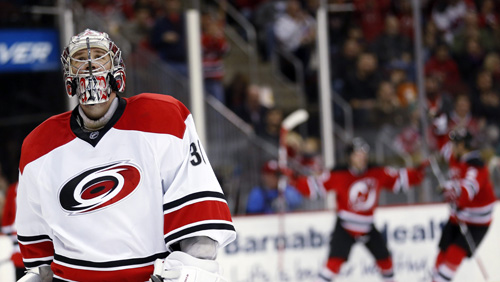NHL DFS Tips
If you’re anything like me, you are a lifelong fan of hockey and the NHL. I have been a highly active DFS user on DraftKings for five wonderful years now, and really love competing in NHL contests. With the NHL All-Star break recently concluded, I missed building my NHL DFS lineups on a regular basis during that four-day span, and competing against people who love hockey and fantasy as much as I do – but thankfully the NHL has returned to business as usual. Below, I outline three tactics that you should be aware of when constructing your NHL DFS lineups, to increase your odds of consistently winning more contests. I also highly recommend checking out FantasyData’s NHL Daily Fantasy Advice Guide. This detailed article will help DFS fans of all levels learning about how to construct a winning lineup for NHL DFS.
1. Matchups vs. Backup Goalies

However, it is important to take note that some backup goalies actually have better save percentage stats than the number one goalie partner. Either the backup goalie is a young player with potential, or they got to start against bad teams while playing at home. If you can, take the extra time to research the backup goalie. Target those with little experience or haven’t started a game over an extended period of time.
2. Favorable Schedules
The NHL season is a grueling 82 game skid with lots of long road trips, taxing back to backs, and other exhausting scheduling situations that makes it tough for players to be at their very best for every single game. Pay attention to teams that have “easy” stretches where they are at home for 6 games over a two week stretch for example, with a couple days or more off in between certain games. You want your lineup’s players to be ideally well rested so they are fresh and ready to put up the offensive stats. Be wary though of teams that have been on the road for a while, and are returning to play their first home game in a while – as that can often be a performance let down for players as they readjust to being home, especially western conference teams that have been playing on the east coast for a while, and are heading home and losing 3 hours due to crossing through time zones. Think of when you are away on vacation for a week or two and then return home, are you on your A-game when you first return to work – likely not, and that’s because you are getting re-calibrated to your everyday home life again. Mind you, you likely do sleep better in your own bed, but sleep is only part of the equation.
3. Salaries vs. Recent Performance
When building your DFS lineups you want to invest into players who have good value at any given time, that is, their salary figure is priced favorably in comparison to their fantasy stats line, most notably their recent performance in games. I enjoy studying the salary component to see how player’s salaries fluctuate in relation to their game’s fantasy point totals. Interestingly enough, I have found that NHL DFS salary numbers stay fairly flat for the most part on DraftKings, even when players are on hot streaks, and those times are the most opportune times to pounce and receive excellent value. Take advantage of a DFS company’s algorithm miscue whenever you can, you need to give yourself every advantage you can to win – especially when you are up against the DFS “sharks” who put in 8-10 hours of research every day to professionally build their lineups.
There are all kinds of tactics that you can utilize on any given day to help increase your contest’s winning percentage odds when it comes to NHL DFS, and the above three are ones to be conscious of during your team and player research process. You likely have your normal routine when it comes to building your NHL DFS lineups, but don’t be afraid to step out of your comfort zone to adapt, evolve, and improve it. After all, your end-goal is to win more contests more often so that you don’t have to top up your account’s funds quite as frequently, or ideally you can actually cash out some funds once in a while – you should be doing everything in your power to do just that when putting your hard earned money on the line.
